Burning the Midnight Oil, Part 2
Last week, I started sharing card-by-card stories from Innistrad: Midnight Hunt. Today, I will share some more.
Ludevic, Necrogenius // Olag, Ludevic's Hubris
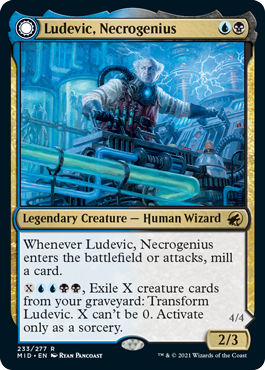
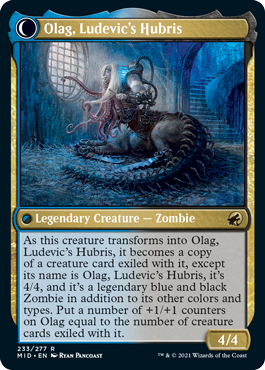
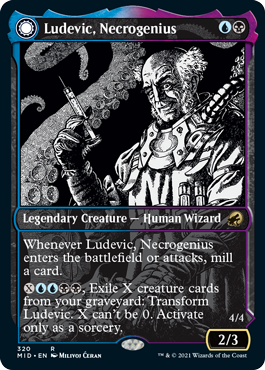
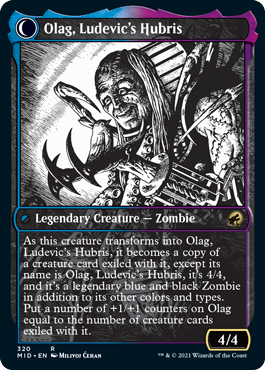
Ludevic has a similar story to Gisa and Geralf. His name appeared in a card in original Innistrad,
Response to that card was lukewarm, so we decided we would use this return to Innistrad to take another shot at it. I should note from the beginning, this slot was a double-faced card slot.
Bon Vivant (front face, version 1)
1B
Creature — Vampire
2/1
Day/Night (As this enters the battlefield, if it's neither day nor night, it becomes day.)
Lifelink
2B: CARDNAME gets +2/+2 until end of turn.
//
Obsessed Recluse (back face, version 1)
Creature — Vampire
2/1
Lunacy
At the beginning of your upkeep, you draw a card and you lose 1 life. [Bon Vivant]
This slot started as a mono-black Vampire design using daybound/nightbound (called just day/night during vision design). It was a cute design with life gain on the front face and life in exchange for card draw on the back face.
Corpse Collector (front face, version 2)
1B
Creature — Human Warlock
2/3
Whenever CARDNAME enters the battlefield or attacks, target player mills three cards. At the beginning of each end step, if there are twenty or more total cards in all graveyards, transform CARDNAME. [Grotesque Amalgam]
//
Grotesque Amalgam (back face, version 2)
Creature — Zombie
As this creature transforms into CARDNAME, exile three creature cards from graveyards. CARDNAME is a copy of the first exiled creature, except it has the power of the second exiled creature and the toughness of the third exiled creature. [Corpse Collector]
The second version of this card changes it from a Vampire to a Zombie Warlock, giving it a whole new mechanic. The front side helped fill up your graveyard, with a graveyard threshold being the transformation condition. The backside then made a Zombie that was a combination of three creature cards in your graveyard.
Ludevic, Mad Scientist (front face, version 3)
UB
Legendary Creature — Human Wizard
2/3
Whenever CARDNAME enters the battlefield or attacks, target player mills three cards. At the beginning of each end step, if there are twenty or more total cards in all graveyards, transform CARDNAME. [Ludevic's Monster]
//
Ludevic's Monster (back face, version 3)
Creature — Zombie
As this creature transforms into CARDNAME, exile three creature cards from graveyards. CARDNAME is a copy of the first exiled creature, except it has the power of the second exiled creature and the toughness of the third exiled creature. [Ludevic, Mad Scientist]
At this point, the Set Design team liked the design, but realized it was a better fit for Ludevic than the card they currently had in the file, so they moved Ludevic from his one-faced slot to this double-faced slot. This is why that other slot (that I talked about last week) changed to mono-black and became Gisa.
Dr. Ludevic, Necro-Visionary (front face, version 4)
UB
Legendary Creature — Human Wizard
2/3
Whenever Doctor Ludevic, Necromaniac enters the battlefield or attacks, target player mills two cards.
{o3oUoB}: You may exile three creature cards from graveyards. If you do, transform Doctor Ludevic. Activate only as a sorcery. [Typo, the Folly of Ludevic]
//
Typo, Ludevic's Monster (back face, version 4)
Creature — Zombie
As this creature transforms into CARDNAME, it becomes a copy of one of the exiled cards, except it has the power of another of those cards, the toughness of the third, and is a Zombie in addition to its other types. [Dr. Ludevic, Necro-Visionary]
The next version kept the back face the same (although with a different template) except it moved the exiling of the three creature cards in your graveyard to the front of the card. To facilitate that, the Set Design team changed the transformation condition from a trigger to an activated ability requiring mana. The front face also dropped from milling three cards to milling two.
The final version changed several things. It dropped the milling from two to one. The fact that the milling kept going down tells me this was a play design change. It changed the transformation cost from exiling exactly three creatures to exiling any number, monitored through an X in the activation cost. It then changed the back so the power/toughness was 4/4 plus a +1/+1 boost for each other creature card exiled. This was done to make the back face creature more exciting.
I hope the result is a Dr. Ludevic with which many of you have fun playing.
Sigarda, Champion of Light
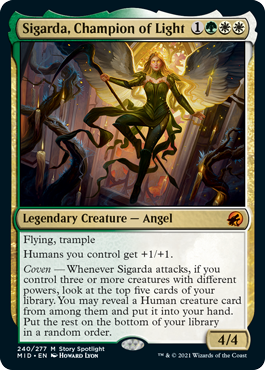
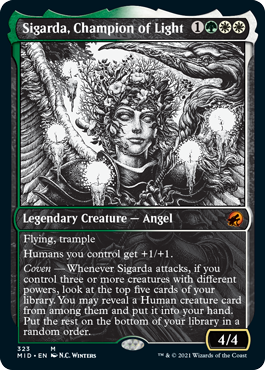
Sigarda first showed up in Avacyn Restored along with her sisters Bruna and Gisela. Due to the events in Shadows over Innistrad block, Sigarda is the only one remaining of the three (although her other sister, Liesa, has returned—see last week's article). Sigarda plays an important role in the story, so we knew she needed a card in the set. Before we look at that, here are her two previous incarnations:
You can see in both that she's played as a protector of the Humans, so that's something we wanted to continue. As an Angel, she obviously had flying and both previous versions of her made use of hexproof. Both versions were also on the bigger side, 4/5 and 5/5. Here's the first stab at her card:
Archangel Sigarda (version 1)
4GW
Legendary Creature — Angel
5/6
Flying
1GW: Creatures you control get +1/+1 until end of turn.
Whenever a creature you control is the target of a spell or ability controlled by an opponent, create X 1/1 white Human creature tokens where X is that creature's power.
The first version is a six-mana 5/6 that boosts your creatures and helps you get lots of 1/1 Human creature tokens. It was flavorful but wasn't exciting anyone.
Archangel Sigarda (version 2)
3GW
Legendary Creature — Angel
4/5
Flying, spell armor 2
Other creatures you control have spell armor 1.
Tap X untapped creatures you control: You may cast a spell with converted mana cost X without paying its mana cost. Activate this ability only any time you could cast a sorcery.
The next version made her one cheaper to cast and shrunk her stats. Trying to capture the flavor of hexproof from her previous versions, this version gets ward (at the time called spell armor) and applies it to all your other creatures. She was then given a very splashy ability that allows you to tap creatures to cast spells out of your hand. I assume this came from the fact that the convoke mechanic has twice been used for Selesnya.
Archangel Sigarda (version 3)
1GW
Legendary Creature — Angel
3/4
Flying
GW: Return target Human creature you control to your hand. If you do, put a +1/+1 counter on CARDNAME. It gains hexproof until end of turn.
The next version makes the card a little more aggressive to capture her personality in the story. (A lot of bad stuff has happened to people close to her, and she's making sure no harm comes to anyone else she cares about.) It now just costs three mana to cast. And while it dropped two mana in its mana cost, it only dropped its stats by 1/1. Her activated ability is one that lets you protect Humans and herself in addition to making her bigger over time.
Archangel Sigarda (version 4)
2GW
Legendary Creature — Angel
4/3
Flying
Other creatures you control get +1/+1.
Festival — As long as you control three or more creatures with different power, whenever a permanent you control is destroyed by or dealt damage by a spell or ability an opponent controls, destroy up to one target nonland permanent that player controls.
This version again shifts her mana cost and stats, this time upward. She boosts creatures and gets the keyword from the Humans, now called coven, but at the time named festival. Again, to stress her aggressive nature, her coven ability allows her to destroy nonland permanents.
Archangel Sigarda (version 5)
1GGW
Legendary Creature — Angel
4/4
Flying, vigilance, trample
Humans creatures you control get +1/+1.
Festival — At the beginning of your upkeep, if you control three or more creatures with different power, you may search your library for a Human creature card, reveal it, and put it into your hand. Then shuffle your library.
Her mana cost changes from 2GW to 1GGW and allows her to upgrade from a 4/3 to a 4/4. She gains vigilance and trample, giving her three creature keywords, one that is white but not green (flying), one that is green but not white (trample), and one that is green and white (vigilance). Her creature pumping now just affects Humans. Her coven ability moves away from the destruction (it was an odd fit for green-white) and becomes a tutoring ability for Humans.
The finished version is close to this last version. Her mana cost changes from 1GGW to 1GWW, she loses vigilance, and her coven ability now looks at the top five cards rather than looking through the whole library.
This last change is part of a big shift R&D has made over the last few years where we're doing more "impulsing" (looking at the top X cards of your library for a certain thing) rather than straight up tutoring (getting any card from your library). The reason for this shift is that tutoring encourages you to have one thing in your deck and guarantees you always get the same thing, where impulsing encourages you to have a wide variety of items in your deck (having a lot requires diversification) and randomizes what you can get from use to use. We feel the latter leads to better gameplay.
Slogurk, the Overslime
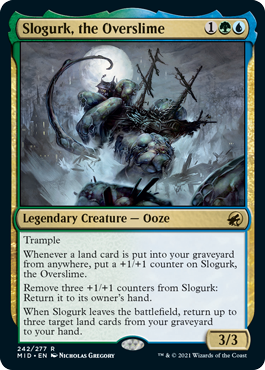
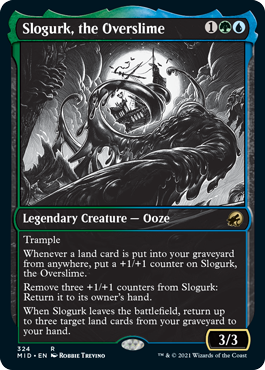
Slogurk is a brand-new legendary creature in Innistrad: Midnight Hunt and Magic's eighth legendary Ooze. As a huge fan of Oozes, I thought it would be fun to look at the many iterations of this card.
Jeleva, Curator of Knowledge (version 1)
1UBR
Legendary Creature — Vampire
4/1
Flying, menace
Whenever CARDNAME attacks, you may cast a spell with flashback from exile without paying its mana cost.
This slot originally was assigned to Jeleva, a Vampire Wizard from Innistrad who first appeared in Commander (2013 Edition). The card was blue-black-red because that's the colors she was on her first card. It was part of a three-color cycle. It didn't take long though before the Set Design team decided they didn't want any three-color cards in the main set and this card got turned into a green-blue slot. (Yeah, I'm not sure how the blue-black-red card became green-blue either, but my best guess is that they removed the three-color cycle and added a two-color cycle, and green-blue ended up falling in this slot.)
Ectoplasmic Entity (version 2)
3GU
Legendary Creature — Ooze
6/6
Trample
When CARDNAME enters the battlefield, mill six cards.
Whenever CARDNAME deals combat damage to a player, you may cast a card with flashback from your graveyard without paying its mana cost.
Once the card was green-blue, the Set Design team correctly figured out it should be a legendary Ooze. This made them make it bigger and change what keyword to use. They kept the cool core concept of the first version, though, letting you have a way to cast flashback cards from the graveyard for free. They changed it from an attack trigger to a saboteur trigger (dealing combat damage to an opponent) and then gave it an "enters the battlefield" trigger that helped you get flashback cards in your graveyard.
The Slither (version 3)
3GU
Legendary Creature — Ooze
6/6
Trample
When CARDNAME enters the battlefield, mill six cards.
Whenever CARDNAME deals combat damage to a player, target instant or sorcery card in your graveyard with flashback gains flashback {o0} until end of turn.
This version is basically the same as the last one, with a new design name and a templating change, but I thought it was cool enough to show you.
The Slither (version 4)
2GU
Legendary Creature — Ooze
4/4
Haste, trample
Whenever a creature deals combat damage to an opponent, you may mill 2.
Whenever a land card is put into your graveyard from anywhere, put a +1/+1 counter on CARDNAME and you gain 1 life.
GU: Put any number of target cards in your graveyard on the bottom of your library in a random order.
This card completely changed, which leads me to believe playtesting showed the ability was problematic (as getting to do stuff for free usually is). The new version leaned more into the Ooze flavor. Oozes tend to grow over time, so this version got a trigger to put +1/+1 counters on it. It then got a saboteur ability to enable that growth, and an activated ability to keep the triggered ability from accidentally killing you. The creature then got haste as that plays well with saboteur abilities. The creature also got cheaper and shrunk a little.
The final version kept the growth element but removed the enablers, as it was believed enough other cards in the set could do that. They then added two abilities to help make it a better creature. The first ability allows you to protect it by unsummoning it when the opponent tries to destroy it. The second ability helps you have the resources to make it grow again. The creature was also made cheaper to combo with the bounce ability and thus shrunk a little in size.
Tovolar, Dire Overlord // Tovolar, the Midnight Scourge
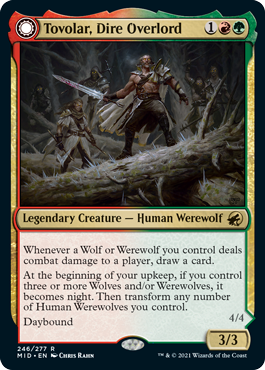
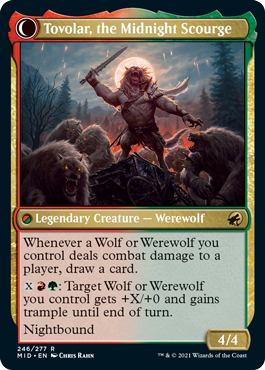
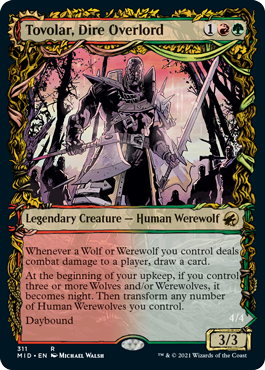
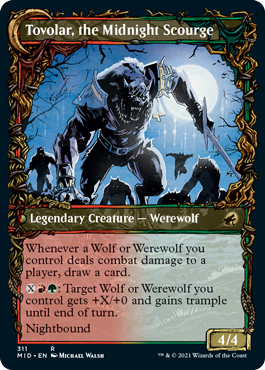
Original Innistrad block didn't have a legendary Werewolf. Commander didn't have quite as big of presence yet, and we just didn't think to make one. Players kept telling us they wanted one, so in Eldritch Moon, we made
The problem was that we made a legendary Werewolf that could serve as a good Commander, but we didn't make a legendary Werewolf designed to be a Commander of a Werewolf deck, so many players were unhappy with Ulrich.
Okay, third time's the charm. This time we knew we had to make a legendary Werewolf that was designed specifically to lead a Werewolf deck. Tovolar was a werewolf that had been referenced before but had never gotten his own card. Innistrad: Midnight Hunt would change that. Here's the first incarnation of Tovolar:
Tovolar, Bloodsinger (front face, version 1)
1BRG
Legendary Creature — Human Werewolf
4/4
Day/Night (When you cast this, if there isn't a day/night token, create one. It starts on the day side.)
4G: Look at the top five cards of your library. You may put a Werewolf card from among them onto the battlefield. Put the other cards on the bottom of your library in a random order.
//
Tovolar, Bloodhowler (back face, version 1)
Legendary Creature — Werewolf
5/5
CARDNAME and other Werewolves you control have haste, lifelink, and trample.
The first stab at Tovolar had him as a three-color creature. This was part of the three-color cycle that Jeleva was also in. Innistrad: Midnight Hunt was introducing black Werewolves (as I talked about last week), so the thought was to make a legendary creature that could use all of them (minus the one white and one blue one). The front face helped you get more Werewolves and the back side made them better by granting them an ability from each of the three colors: haste (red), lifelink (black), and trample (green).
Tovolar, Bloodsinger (version 2)
1RG
Legendary Creature — Human Werewolf
3/3
Nightfall – (As this enters the battlefield, if there isn't a day/night tracker, create one.) Whenever another Werewolf enters the battlefield under your control, draw a card. [Tovolar, Bloodhowler]
//
Tovolar, Bloodhowler (version 2)
Legendary Creature — Werewolf
5/5
Nightfall – Whenever this creature transforms into CARDNAME, transform all untransformed Werewolves you control. As long as it's night, each Werewolf you control enters the battlefield transformed and can't become untransformed. You may cast Werewolves as though they have flash. Whenever another Werewolf enters the battlefield under your control, draw a card. [Tovolar, Bloodsinger]
When the three-color cycle got removed, Tovolar dropped to being red-green, as those are the main Werewolf colors. The front face went from being something that enables Werewolves to a card that rewards them. We wanted to make this a potent card, and drawing cards has proven to be a strong reward.
The backside is a bit odd. There's a lot of text basically spelling out what nightbound means. My best guess is that they were tweaking how exactly daybound/nightbound was going to work, and so they were spelling things out at the time. Other than that, it grants Werewolves flash and keeps the card-drawing aspect from the other side.
Tovolar, Bloodsinger (version 3)
1RG
Legendary Creature — Human Werewolf
3/3
Daybound – (If the active player doesn't cast a spell during their turn, it becomes night as the next turn begins.) Whenever a Wolf or Werewolf you control deals combat damage to a player or planeswalker, draw a card. At the beginning of your upkeep, if you control another Wolf or Werewolf, it becomes night. Then transform any number of Human Werewolves you control. [Tovolar of the Long Night]
//
Tovolar of the Long Night (version 3)
Legendary Creature — Werewolf
5/4
Nightbound – (If the active player casts two or more spells during their turn, it becomes day as the next turn begins.) Whenever a Wolf or Werewolf you control deals combat damage to a player or planeswalker, draw a card.
2RG: Target Wolf or Werewolf you control gets +X/+X and gains trample until end of turn, where X is the number of Wolves and Werewolves you control. [Tovolar, Bloodsinger]
Drawing a card for playing a Werewolf ended up being too strong, so they changed it to a saboteur trigger. They also added a second transform trigger, so now just having a lot of Werewolves made it night. I'm pretty sure this was added because one of the biggest problems in Commander is that it's hard to take a turn off from casting spells. The back face matched the change to the saboteur trigger and gained an activated ability that boosted your Wolves and Werewolves.
The only change on the front face of the printed card is that it now requires three Werewolves to transform rather than two. The back face changed two things: one, the X is now defined by mana rather than the number of Wolves and Werewolves; and two, it only pumps power. The latter was due to playtesting. We've found that toughness boosting both significantly raises the power level of a card and adds a decent amount of board complexity, so it's common for us to often just boost power.
Here Comes the Sun
We've come to the end of today's storytelling. I hope you had fun. As always, I'm eager to hear your thoughts on this column, on any of the cards I talked about, or on Innistrad: Midnight Hunt itself. You can email me or contact me through any of my social media accounts (Twitter, Tumblr, Instagram, and TikTok).
Join me next week for a Innistrad: Midnight Hunt mailbag column where I answer your questions about the set.
Until then, may your howl always be one of joy.

